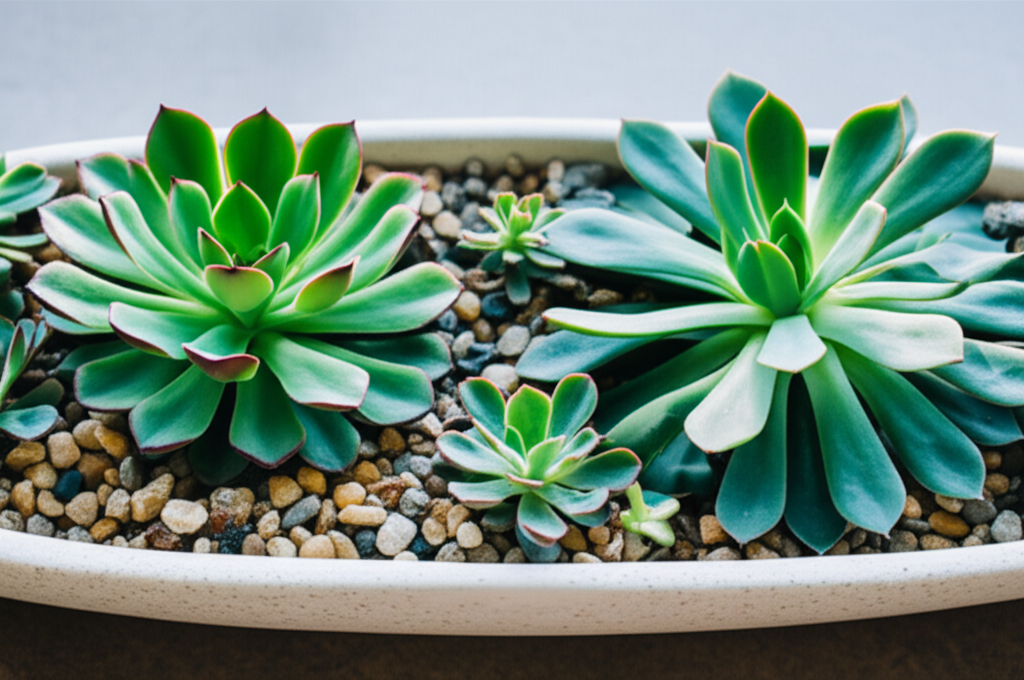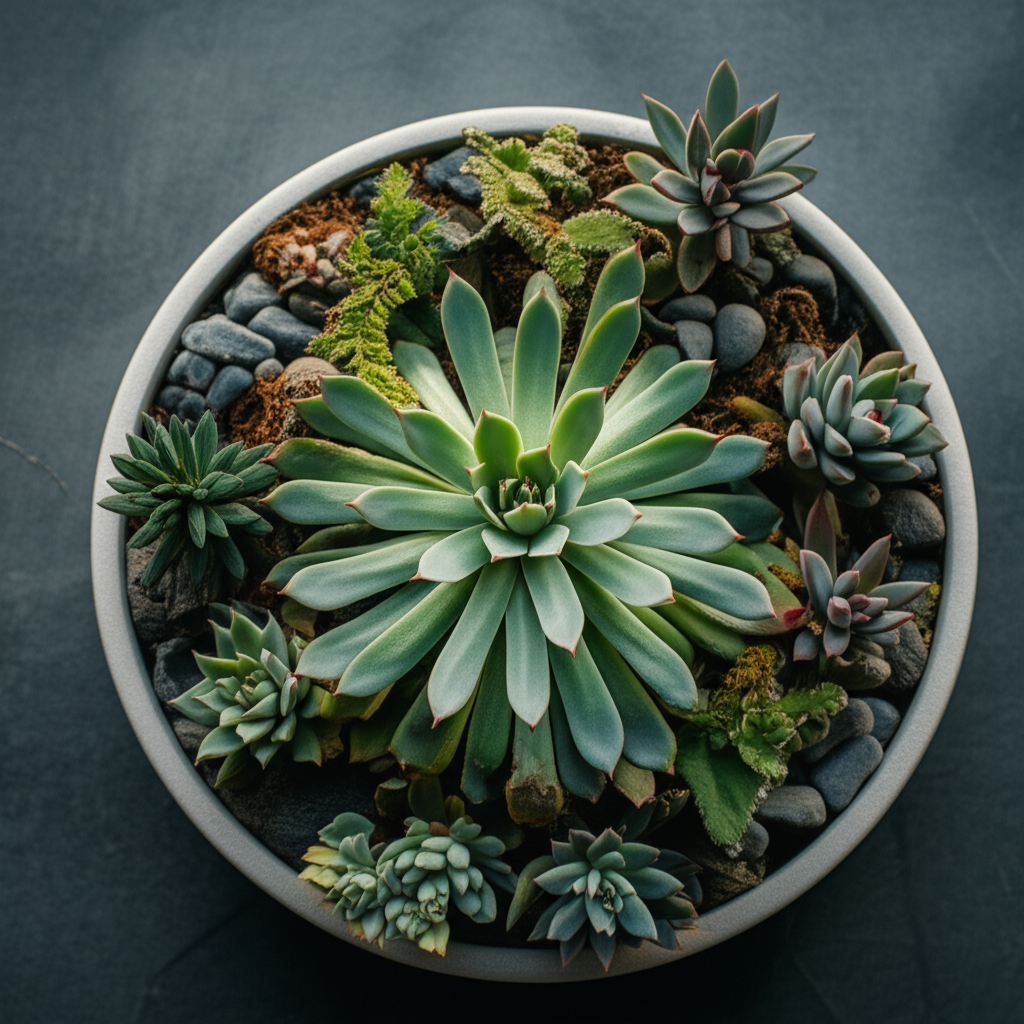Introduction: The Allure of the Ice Plant Succulent Table Garden
Imagine a miniature desert oasis gracing your coffee table, a vibrant splash of color and texture that requires minimal fuss. The ice plant succulent, with its jewel-like papillae and captivating bloom, is the perfect candidate for a decorative table garden. These resilient plants, belonging to the Aizoaceae family, are not only visually stunning but also incredibly low-maintenance, making them ideal for busy individuals or those new to plant care. This article will guide you through the process of designing, assembling, and maintaining a breathtaking ice plant succulent table garden, transforming any tabletop into a miniature work of art.
Understanding Ice Plant Succulents: More Than Just Pretty Faces

Ice plants, scientifically known as Mesembryanthemums, are renowned for their unique epidermal cells, called papillae, which resemble tiny droplets of ice. These papillae serve multiple purposes: reflecting excess sunlight, reducing water loss, and even collecting dew. This remarkable adaptation allows them to thrive in arid environments, making them exceptionally drought-tolerant.
Key Characteristics of Ice Plant Succulents
- Papillae: The most distinctive feature, giving them their name.
- Drought Tolerance: Able to survive long periods without water.
- Sunlight Requirements: Generally require bright, direct sunlight.
- Flowering: Many varieties produce vibrant, daisy-like flowers.
- Growth Habit: Can be trailing, creeping, or upright, offering diverse design possibilities.
Designing Your Ice Plant Succulent Table Garden
The beauty of a table garden lies in its potential for creative expression. When designing your ice plant arrangement, consider the container, the color palette, the textures, and the overall aesthetic you wish to achieve.
Choosing the Right Container
The container is the foundation of your table garden. For ice plants, opt for shallow, wide containers that offer good drainage.
Popular Container Options:
- Ceramic or Terracotta Bowls: Classic choices that offer excellent drainage and breathability.
- Shallow Wooden Planters: Add a rustic, natural touch. Ensure they are treated for outdoor use if exposed to moisture.
- Repurposed Trays or Platters: A great way to upcycle and create a unique look.
- Glass Terrariums (with caveats): While visually appealing, glass terrariums can trap humidity, which ice plants generally dislike. If using a glass container, ensure it is open and has excellent air circulation.
Selecting Your Ice Plant Varieties
The diversity within the ice plant family offers a wide range of colors, textures, and growth habits to create a dynamic and visually engaging arrangement.
Recommended Ice Plant Varieties for Table Gardens:
- Delosperma cooperi (Hardy Ice Plant): Known for its vibrant purple-pink flowers and spreading habit.
- Lampranthus spectabilis (Showy Ice Plant): Offers masses of bright, colorful blooms in shades of pink, orange, and yellow.
- Aptenia cordifolia (Heartleaf Ice Plant): Features trailing stems with heart-shaped leaves, perfect for a cascading effect.
- Conophytum species: Smaller, more compact varieties that resemble pebbles, offering a unique “living stone” aesthetic.
- Lithops species (Living Stones): While not technically ice plants, their succulent nature and unusual appearance make them excellent companions in a desert-themed table garden.
Incorporating Complementary Elements
To enhance the visual appeal and create a more complete miniature landscape, consider adding complementary elements.
Decorative Elements:
- Gravel and Sand: Different colored gravels and sands can mimic desert terrains and improve drainage.
- Small Stones and Pebbles: Add texture and visual interest.
- Driftwood or Small Branches: Introduce natural structure and scale.
- Miniature Figurines: Add a touch of whimsy and personality.
Assembling Your Ice Plant Succulent Table Garden
The assembly process is where your design vision comes to life. Follow these steps to create a stunning and healthy arrangement.
Step-by-Step Assembly Guide
- Prepare the Container: Ensure the chosen container has adequate drainage holes. If not, you may need to drill them or use a layer of gravel at the bottom to prevent waterlogging.
- Add Drainage Layer: Place a layer of coarse gravel or pebbles at the bottom of the container.
- Introduce the Soil Mix: Use a well-draining succulent or cactus potting mix. You can create your own by combining potting soil with perlite and coarse sand in a 2:1:1 ratio.
- Position Your Plants: Arrange your ice plant succulents, considering their growth habits and desired aesthetic. Place taller varieties towards the back or center, and trailing varieties around the edges.
- Fill in Gaps: Use additional soil mix to fill in any gaps between the plants, ensuring the roots are covered.
- Add Decorative Elements: Arrange your chosen gravel, stones, or driftwood to create your desired landscape.
- Initial Watering: Water the garden lightly after planting to settle the soil. Avoid overwatering, as this can lead to root rot.
Caring for Your Ice Plant Succulent Table Garden
The beauty of ice plants lies in their resilience, but a little care goes a long way in ensuring their continued health and vibrancy.
Key Care Requirements
- Sunlight: Ice plants thrive in bright, direct sunlight. Aim for at least 6-8 hours of sunlight per day. If placed indoors, a south-facing window is ideal.
- Watering: Water thoroughly only when the soil has completely dried out. Overwatering is the most common cause of succulent death. Check the soil moisture by sticking your finger about an inch deep.
- Soil: As mentioned, a well-draining succulent mix is crucial.
- Temperature: Most ice plants prefer warm temperatures. Protect them from frost.
- Fertilizing: Ice plants are not heavy feeders. Fertilize sparingly during the growing season (spring and summer) with a diluted succulent fertilizer, about once a month.
- Pruning: Prune to maintain shape, remove dead or damaged growth, and encourage bushier growth. Pruning can also be done to propagate new plants.
Troubleshooting Common Issues
- Yellowing Leaves: Often indicates overwatering. Allow the soil to dry out completely and reduce watering frequency.
- Mushy Stems or Leaves: A clear sign of root rot, usually due to overwatering and poor drainage. Repot the plant in fresh, dry soil and trim away any rotten roots.
- Stretched Growth (Etiolation): Occurs when plants don’t receive enough light. Move the plant to a brighter location.
- Pests: Mealybugs and spider mites can sometimes affect succulents. Treat with insecticidal soap or neem oil.
Key Facts and Comparison: Ice Plants vs. Other Table Garden Succulents
To further appreciate the unique advantages of ice plants for table gardens, let’s compare them to other popular succulent choices.
| Feature | Ice Plant Succulents | Echeveria | Sempervivum (Hens and Chicks) | Haworthia |
|---|---|---|---|---|
| Papillae/Texture | Distinctive, ice-like cells; varied textures. | Rosette-shaped leaves, smooth or powdery. | Tight rosettes, often with fuzzy or spiky edges. | Often translucent or windowed leaves, geometric patterns. |
| Sunlight Needs | High (bright, direct sun). | High (bright, indirect to direct sun). | High (full sun). | Moderate to low (bright, indirect light). |
| Watering Needs | Low (drought tolerant). | Low (drought tolerant). | Low (drought tolerant). | Low to moderate. |
| Growth Habit | Trailing, creeping, upright; can spread. | Rosette, compact. | Rosette, produces offsets (“chicks”). | Rosette, offsets. |
| Flowering | Often prolific, bright, daisy-like. | Tall flower stalks, often bell-shaped. | Small, star-shaped flowers on tall stalks. | Thin flower stalks, small flowers. |
| Ideal for Table Gardens? | Excellent, especially trailing varieties for visual interest. | Very good, for compact and colorful arrangements. | Good, but can grow outwards quickly. | Good, for low-light indoor spaces. |
Pros and Cons of Ice Plant Succulent Table Gardens
Like any gardening endeavor, there are advantages and disadvantages to consider when choosing ice plants for your table garden.
| Pros | Cons |
|---|---|
| Low Maintenance: Extremely drought tolerant and forgiving of neglect. | Light Requirements: Need significant direct sunlight, which may not be available in all indoor spaces. |
| Unique Aesthetics: The papillae provide a distinctive visual appeal. | Overwatering Risk: Despite drought tolerance, overwatering is a common pitfall for beginners. |
| Vibrant Blooms: Many varieties produce stunning, colorful flowers. | Can Spread: Some trailing varieties can outgrow their containers relatively quickly. |
| Versatile Design: Various growth habits allow for diverse arrangements. | Sensitivity to Frost: Most varieties are not frost-hardy and need protection in colder climates. |
| Durable: Generally robust and resistant to many common plant pests. | Limited Indoor Low-Light Options: Not ideal for dimly lit corners compared to some other succulents. |
Creative Ideas for Your Ice Plant Succulent Table Garden
Beyond the basic assembly, several creative approaches can elevate your ice plant table garden into a true centerpiece.
Themed Arrangements
- Desert Mirage: Combine various ice plants with cacti, small stones, and coarse sand for a quintessential desert look.
- Coastal Serenity: Use a shallow, weathered blue ceramic bowl, white sand, and smooth pebbles to evoke a coastal feel, perhaps with a trailing ice plant resembling seafoam.
- Zen Garden: Incorporate smooth river stones, a small raked sand section, and a minimalist arrangement of compact ice plants for a tranquil, meditative display.
Seasonal Adaptations
While ice plants are generally hardy, you can adapt your table garden for different seasons:
- Spring/Summer: Emphasize flowering varieties and brighter colors. Add colorful decorative stones or small painted figurines.
- Autumn: Incorporate warmer-toned gravel and perhaps a small decorative gourd or mini pumpkin.
- Winter: Focus on the unique textures of the ice plants. You might add frosted glass pebbles or silver accents. If your climate is cold, ensure your table garden is moved indoors to a sunny, frost-free location.
Propagating Your Ice Plant Succulents
One of the joys of growing ice plants is their ease of propagation. This allows you to expand your collection or create new table gardens.
Methods of Propagation
- Cuttings: The most common method. Take stem cuttings from healthy plants, allow them to callus over for a few days, and then plant them in well-draining soil.
- Offsets (Pups): Many ice plants produce small offshoots at the base of the parent plant. Carefully separate these with a clean knife and pot them as new plants.
- Seed:** While possible, growing from seed is a slower process and generally less common for table garden enthusiasts.
Conclusion: A Living Masterpiece for Your Table
Creating an ice plant succulent table garden is a rewarding experience that brings a touch of living art into your home. With their captivating textures, vibrant blooms, and remarkable resilience, ice plants are the perfect subjects for a low-maintenance yet visually stunning display. By understanding their needs and employing a little creativity, you can cultivate a miniature desert landscape that will be admired for its beauty and simplicity for years to come. Embrace the process, experiment with different varieties and decorative elements, and enjoy the enchanting world of ice plant succulents right at your fingertips.


